Abstract
Seropositive rheumatoid arthritis (RA) in adult and juvenile patients is associated with the serologic marker HLA-DR4. This association is incomplete; about one-third of the patients lack the disease-associated HLA-DR4 haplotype. The main biological function of class II molecules is to restrict the recognition of antigen by T lymphocytes. We therefore tested the hypothesis that patients with seropositive RA share T cell recognition sites for an unknown antigen and that such T cell "epitopes" are not identified by conventional serologic typing. We generated alloreactive human T cell clones by stimulating peripheral blood lymphocytes of normal donors against a lymphoblastoid cell line from a juvenile patient with seropositive RA. A panel of clones that recognized only HLA-Dw14 cells on a panel of homozygous typing cells was used to analyze class II molecules of adult patients with seropositive RA. By inhibition studies using monoclonal antibodies, the epitopes recognized by the different clones could be further characterized and assigned either to DR- or to DQ-encoded cell surface products. By using four different clones, it was possible to identify Dw14-associated T cell epitopes on all seropositive rheumatoid patients tested who typed HLA-DR4-positive and also on all eight DR4-negative patients tested. Approximately one-half of nonrheumatoid DR4-positive donors carried one or more determinants recognized by these clones; the expression of these allodeterminants in DR4-negative nonrheumatoid patients was rare (less than 10%). Thus, alloreactive human T cell clones are powerful tools to define T cell recognition sites on class II molecules that are not identified by conventional typing. Using T cell clones with specificities for determinants expressed on Dw14 homozygous typing lines, we were able to demonstrate shared epitopes on cells of all patients tested with seropositive RA irrespective of their HLA-D or HLA-DR type. These data suggest that major histocompatibility complex class II antigens of RA patients might be much more homogeneous than demonstrated by the incomplete HLA-DR4 association.
Full text
PDF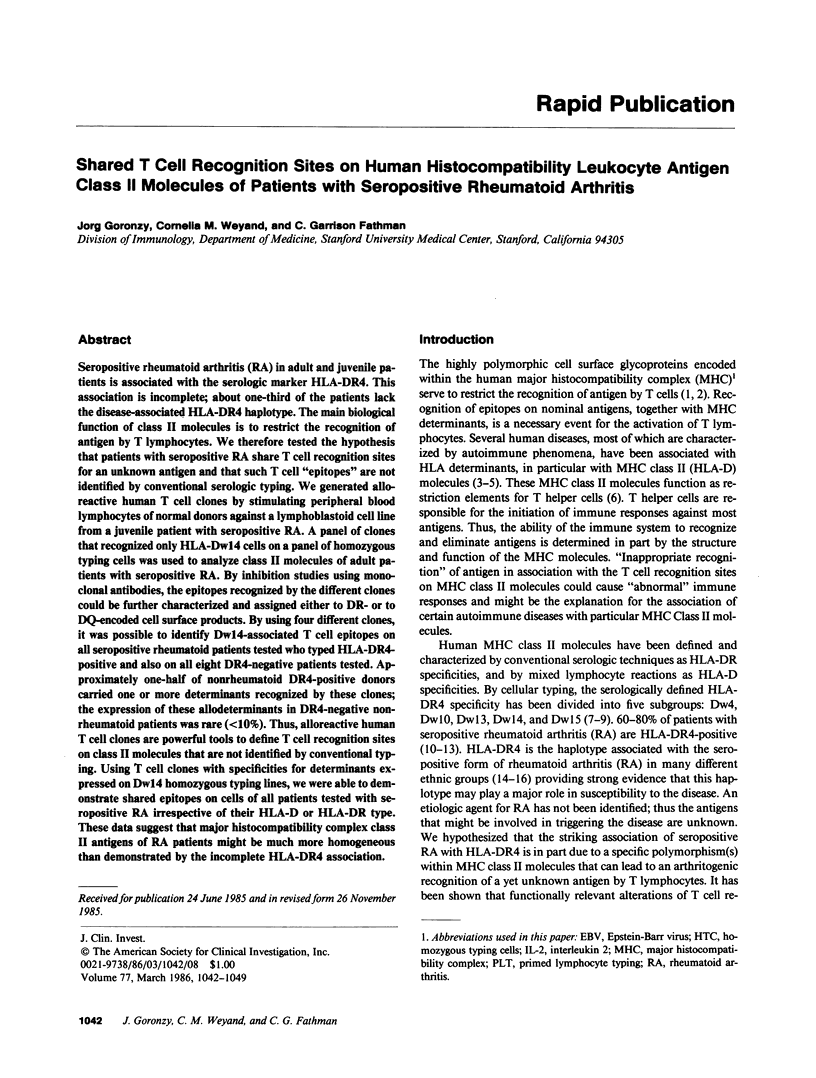
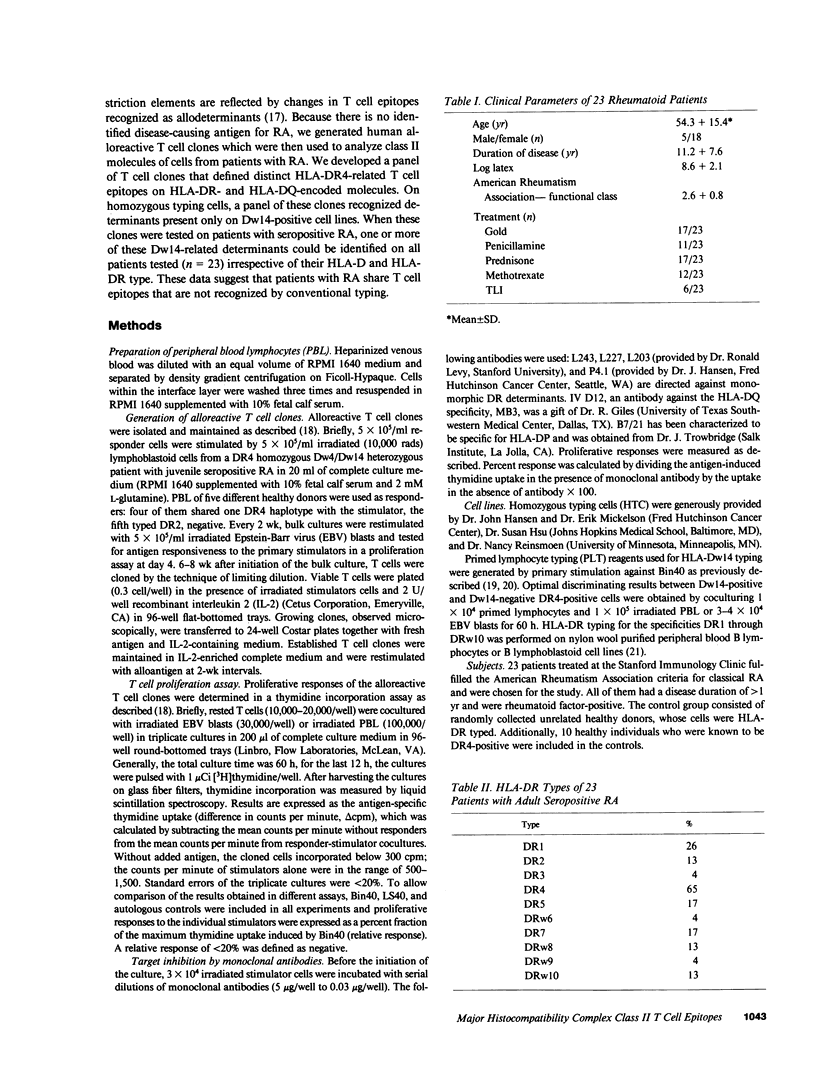
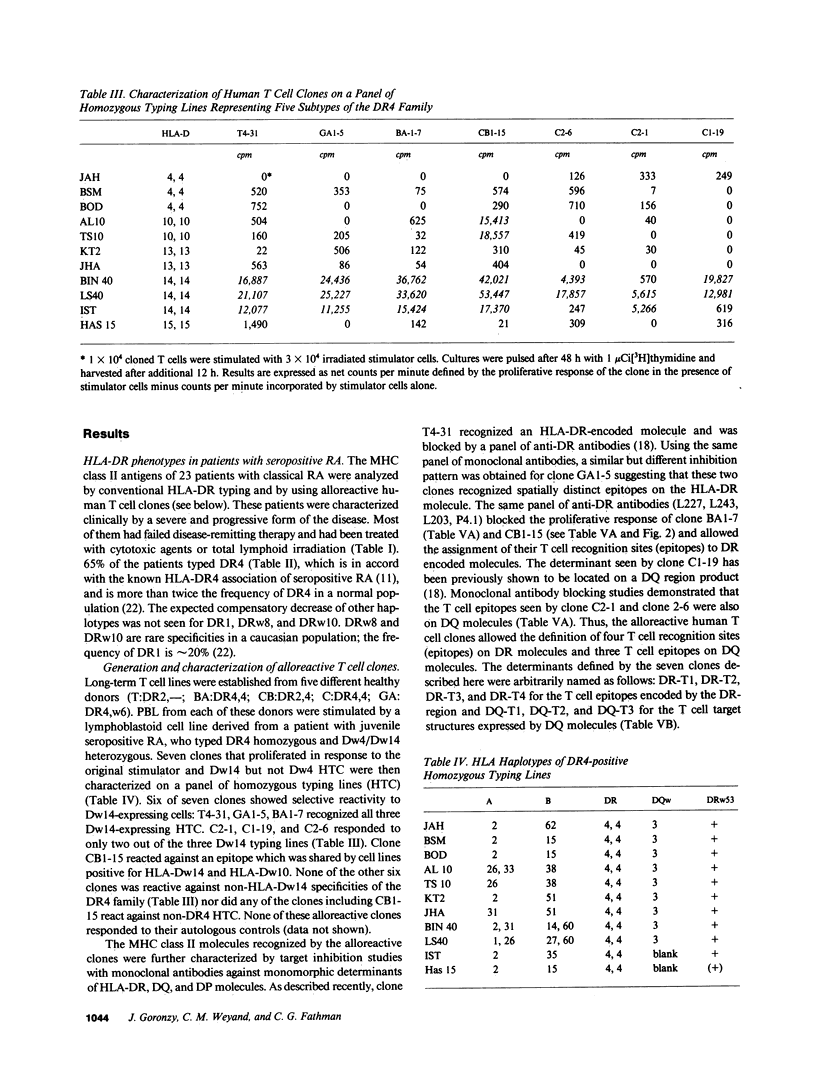
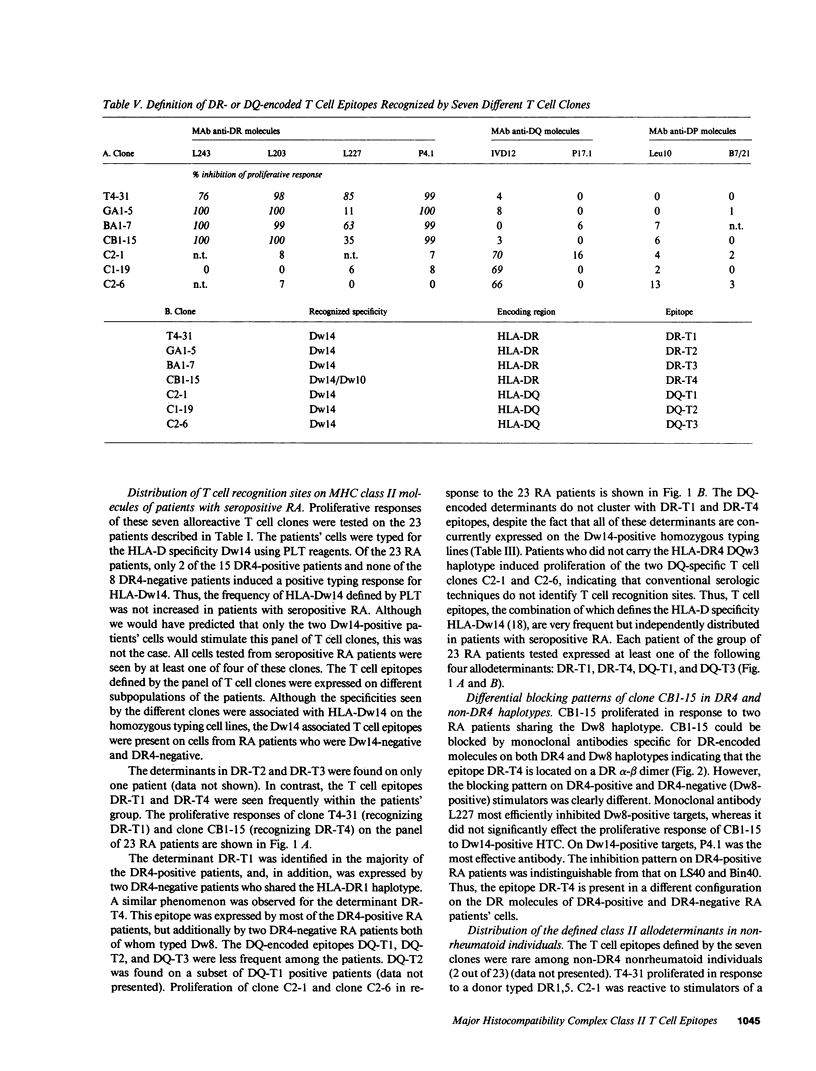
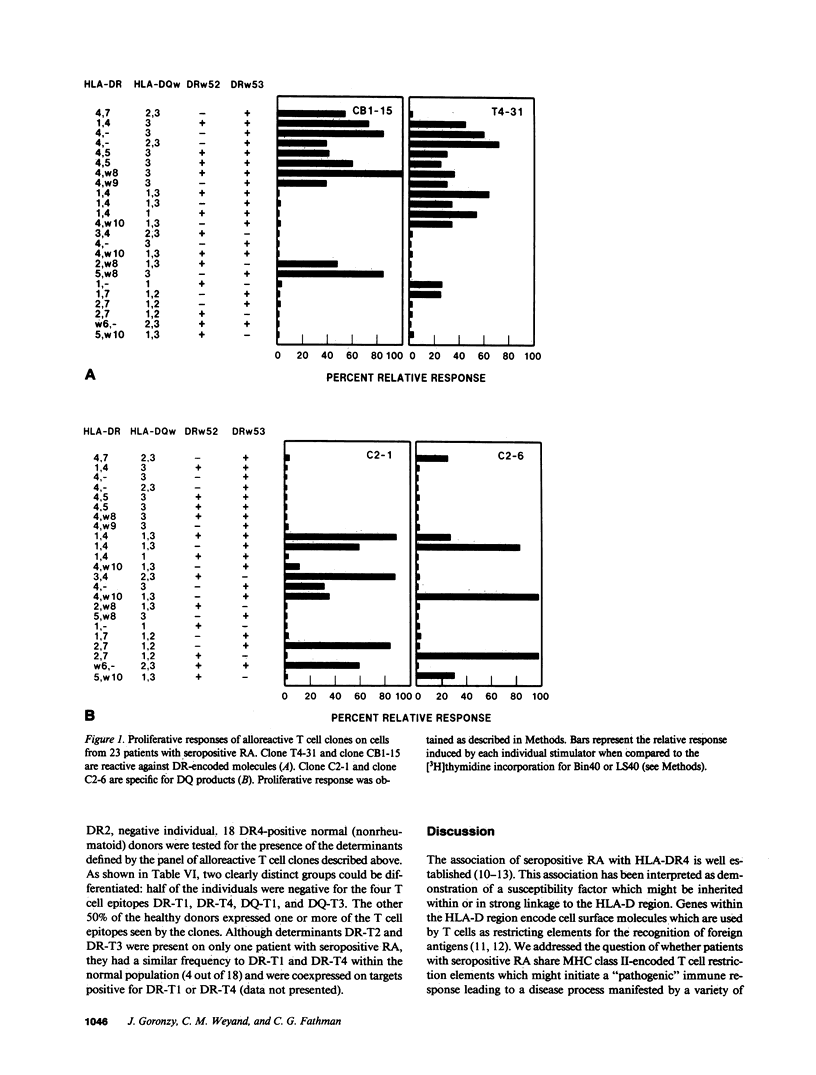
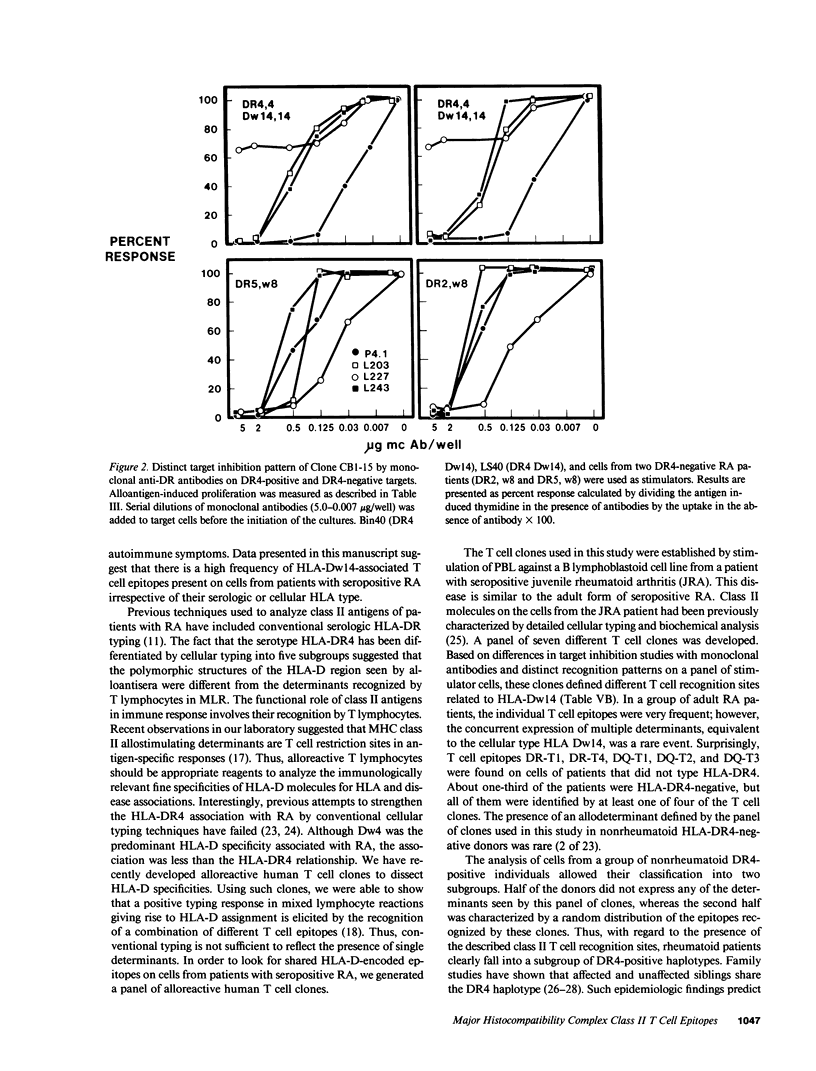
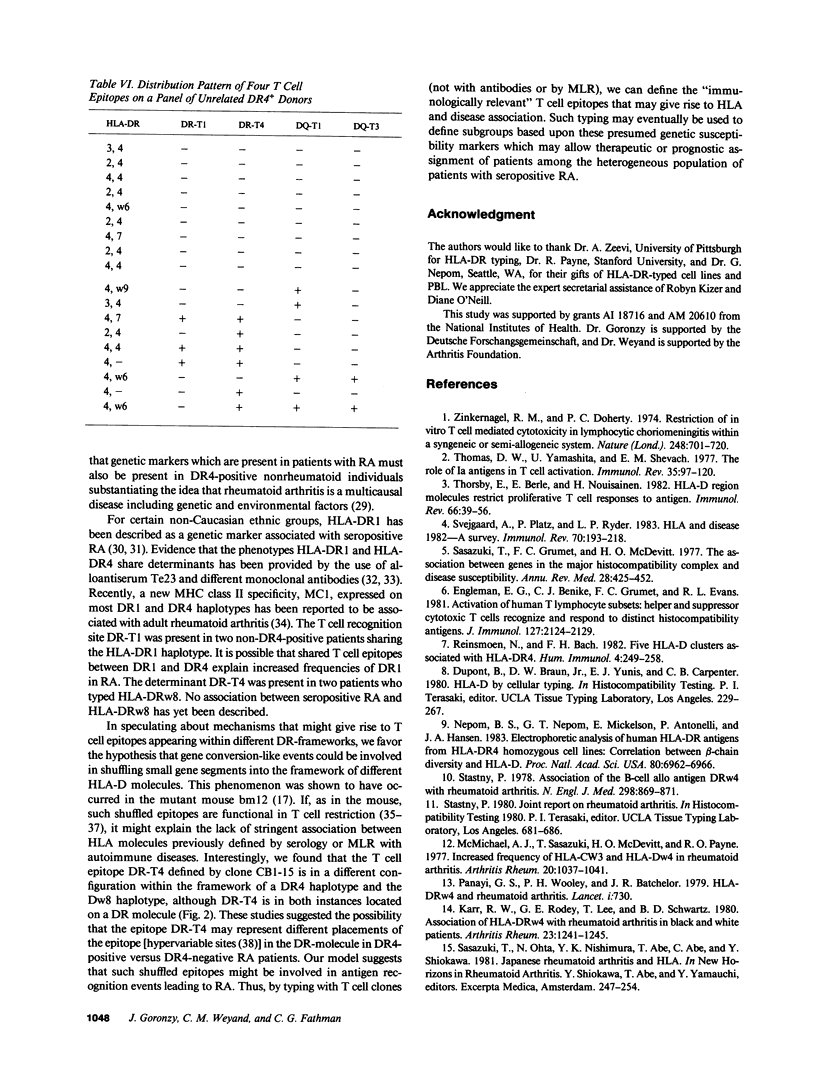
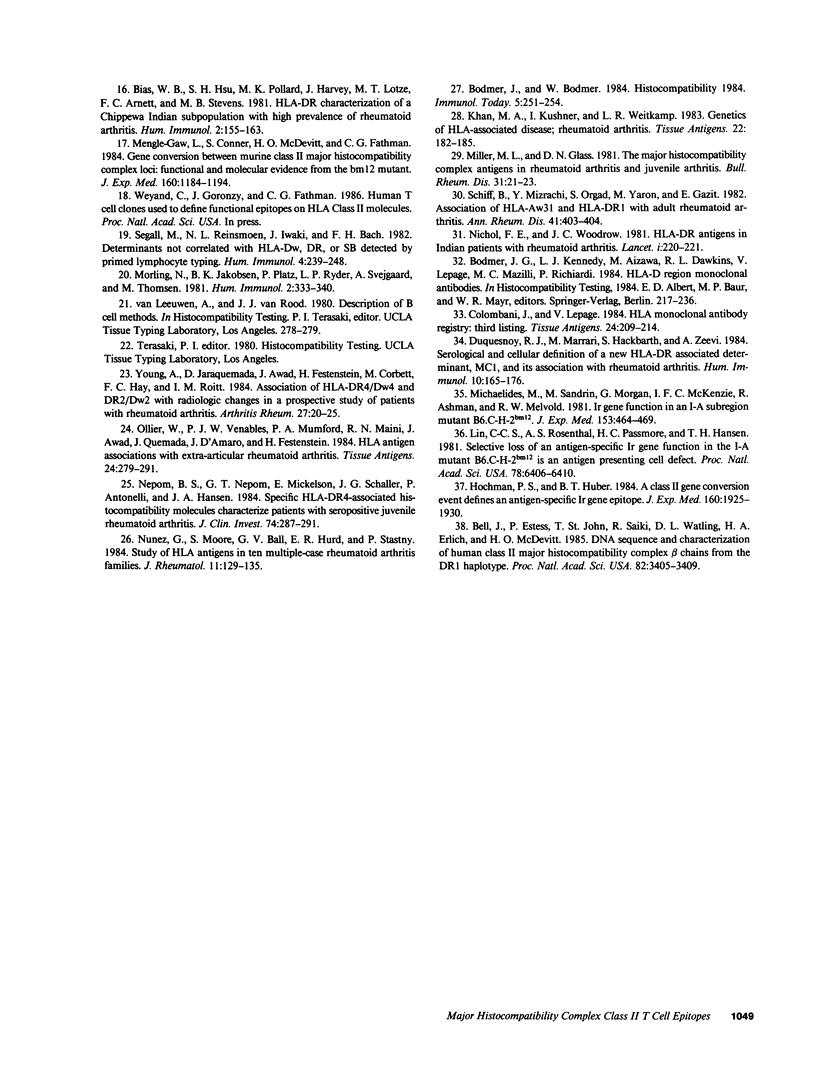
Selected References
These references are in PubMed. This may not be the complete list of references from this article.
- Bell J. I., Estess P., St John T., Saiki R., Watling D. L., Erlich H. A., McDevitt H. O. DNA sequence and characterization of human class II major histocompatibility complex beta chains from the DR1 haplotype. Proc Natl Acad Sci U S A. 1985 May;82(10):3405–3409. doi: 10.1073/pnas.82.10.3405. [DOI] [PMC free article] [PubMed] [Google Scholar]
- Bias W. B., Hsu S. H., Pollard M. K., Harvey J., Lotze M. T., Arnett F. C., Stevens M. B. HLA-DR characterization of a Chippewa Indian subpopulation with high prevalence of rheumatoid arthritis. Hum Immunol. 1981 Mar;2(2):155–163. doi: 10.1016/0198-8859(81)90062-8. [DOI] [PubMed] [Google Scholar]
- Colombani J., Lepage V. HLA monoclonal antibody registry: third listing. Tissue Antigens. 1984 Oct;24(4):209–214. doi: 10.1111/j.1399-0039.1984.tb02129.x. [DOI] [PubMed] [Google Scholar]
- Duquesnoy R. J., Marrari M., Hackbarth S., Zeevi A. Serological and cellular definition of a new HLA-DR associated determinant, MC1, and its association with rheumatoid arthritis. Hum Immunol. 1984 Jul;10(3):165–176. doi: 10.1016/0198-8859(84)90037-5. [DOI] [PubMed] [Google Scholar]
- Engleman E. G., Benike C. J., Grumet F. C., Evans R. L. Activation of human T lymphocyte subsets: helper and suppressor/cytotoxic T cells recognize and respond to distinct histocompatibility antigens. J Immunol. 1981 Nov;127(5):2124–2129. [PubMed] [Google Scholar]
- Hochman P. S., Huber B. T. A class II gene conversion event defines an antigen-specific Ir gene epitope. J Exp Med. 1984 Dec 1;160(6):1925–1930. doi: 10.1084/jem.160.6.1925. [DOI] [PMC free article] [PubMed] [Google Scholar]
- Karr R. W., Rodey G. E., Lee T., Schwartz B. D. Association of HLA-DRw4 with rheumatoid arthritis in black and white patients. Arthritis Rheum. 1980 Nov;23(11):1241–1245. doi: 10.1002/art.1780231102. [DOI] [PubMed] [Google Scholar]
- Khan M. A., Kushner I., Weitkamp L. R. Genetics of HLA-associated disease; rheumatoid arthritis. Tissue Antigens. 1983 Sep;22(3):182–185. doi: 10.1111/j.1399-0039.1983.tb01189.x. [DOI] [PubMed] [Google Scholar]
- Lin C. C., Rosenthal A. S., Passmore H. C., Hansen T. H. Selective loss of antigen-specific Ir gene function in IA mutant B6.C-H-2bm12 is an antigen presenting cell defect. Proc Natl Acad Sci U S A. 1981 Oct;78(10):6406–6410. doi: 10.1073/pnas.78.10.6406. [DOI] [PMC free article] [PubMed] [Google Scholar]
- McMichael A. J., Sasazuki T., McDevitt H. O., Payne R. O. Increased frequency of HLA-Cw3 and HLA-Dw4 in rheumatoid arthritis. Arthritis Rheum. 1977 Jun;20(5):1037–1042. doi: 10.1002/art.1780200501. [DOI] [PubMed] [Google Scholar]
- Mengle-Gaw L., Conner S., McDevitt H. O., Fathman C. G. Gene conversion between murine class II major histocompatibility complex loci. Functional and molecular evidence from the bm 12 mutant. J Exp Med. 1984 Oct 1;160(4):1184–1194. doi: 10.1084/jem.160.4.1184. [DOI] [PMC free article] [PubMed] [Google Scholar]
- Michaelides M., Sandrin M., Morgan G., McKenzie I. F., Ashman R., Melvold R. W. Ir gene function in an I-A subregion mutant B6.C-H-2bm12. J Exp Med. 1981 Feb 1;153(2):464–469. doi: 10.1084/jem.153.2.464. [DOI] [PMC free article] [PubMed] [Google Scholar]
- Miller M. L., Glass D. N. The major histocompatibility complex antigens in rheumatoid arthritis and juvenile arthritis. Bull Rheum Dis. 1981;31(5):21–25. [PubMed] [Google Scholar]
- Morling N., Jakobsen B. K., Platz P., Ryder L. P., Svejgaard A., Thomsen M. Typing for human alloantigens with the primed lymphocyte typing (PLT) technique with notes on the interpretation of PLT data. Hum Immunol. 1981 Jul;2(4):333–340. doi: 10.1016/0198-8859(81)90035-5. [DOI] [PubMed] [Google Scholar]
- Nepom B. S., Nepom G. T., Mickelson E., Antonelli P., Hansen J. A. Electrophoretic analysis of human HLA-DR antigens from HLA-DR4 homozygous cell lines: correlation between beta-chain diversity and HLA-D. Proc Natl Acad Sci U S A. 1983 Nov;80(22):6962–6966. doi: 10.1073/pnas.80.22.6962. [DOI] [PMC free article] [PubMed] [Google Scholar]
- Nepom B. S., Nepom G. T., Mickelson E., Schaller J. G., Antonelli P., Hansen J. A. Specific HLA-DR4-associated histocompatibility molecules characterize patients with seropositive juvenile rheumatoid arthritis. J Clin Invest. 1984 Jul;74(1):287–291. doi: 10.1172/JCI111413. [DOI] [PMC free article] [PubMed] [Google Scholar]
- Nichol F. E., Woodrow J. C. HLA DR antigens in Indian patients with rheumatoid arthritis. Lancet. 1981 Jan 24;1(8213):220–221. doi: 10.1016/s0140-6736(81)90092-1. [DOI] [PubMed] [Google Scholar]
- Nunez G., Moore S. E., Ball G. V., Hurd E. R., Stastny P. Study of HLA antigens in ten multiple-case rheumatoid arthritis families. J Rheumatol. 1984 Apr;11(2):129–135. [PubMed] [Google Scholar]
- Ollier W., Venables P. J., Mumford P. A., Maini R. N., Awad J., Jaraquemada D., D'Amaro J., Festenstein H. HLA antigen associations with extra-articular rheumatoid arthritis. Tissue Antigens. 1984 Nov;24(5):279–291. doi: 10.1111/j.1399-0039.1984.tb02139.x. [DOI] [PubMed] [Google Scholar]
- Panayi G. S., Wooley P. H., Batchelor J. R. HLA-DRw4 and rheumatoid arthritis. Lancet. 1979 Mar 31;1(8118):730–730. doi: 10.1016/s0140-6736(79)91186-3. [DOI] [PubMed] [Google Scholar]
- Reinsmoen N. L., Bach F. H. Five HLA-D clusters associated with HLA-DR4. Hum Immunol. 1982 Jun;4(3):249–258. doi: 10.1016/0198-8859(82)90040-4. [DOI] [PubMed] [Google Scholar]
- Sasazuki T., McDevitt H. O., Grumet F. C. The association between genes in the major histocompatibility complex and disease susceptibility,. Annu Rev Med. 1977;28:425–452. doi: 10.1146/annurev.me.28.020177.002233. [DOI] [PubMed] [Google Scholar]
- Schiff B., Mizrachi Y., Orgad S., Yaron M., Gazit E. Association of HLA-Aw31 and HLA-DR1 with adult rheumatoid arthritis. Ann Rheum Dis. 1982 Aug;41(4):403–404. doi: 10.1136/ard.41.4.403. [DOI] [PMC free article] [PubMed] [Google Scholar]
- Segall M., Reinsmoen N. L., Iwaki J., Bach F. H. Determinants not correlated with HLA-Dw, DR, or SB detected by primed lymphocyte typing. Hum Immunol. 1982 Jun;4(3):239–248. doi: 10.1016/0198-8859(82)90039-8. [DOI] [PubMed] [Google Scholar]
- Stastny P. Association of the B-cell alloantigen DRw4 with rheumatoid arthritis. N Engl J Med. 1978 Apr 20;298(16):869–871. doi: 10.1056/NEJM197804202981602. [DOI] [PubMed] [Google Scholar]
- Svejgaard A., Platz P., Ryder L. P. HLA and disease 1982--a survey. Immunol Rev. 1983;70:193–218. doi: 10.1111/j.1600-065x.1983.tb00715.x. [DOI] [PubMed] [Google Scholar]
- Thomas D. W., Yamashita U., Shevach E. M. The role of Ia antigens in T cell activation. Immunol Rev. 1977;35:95–120. doi: 10.1111/j.1600-065x.1977.tb00237.x. [DOI] [PubMed] [Google Scholar]
- Thorsby E., Berle E., Nousiainen H. HLA-D region molecules restrict proliferative T cell responses to antigen. Immunol Rev. 1982;66:39–56. doi: 10.1111/j.1600-065x.1982.tb00433.x. [DOI] [PubMed] [Google Scholar]
- Young A., Jaraquemada D., Awad J., Festenstein H., Corbett M., Hay F. C., Roitt I. M. Association of HLA-DR4/Dw4 and DR2/Dw2 with radiologic changes in a prospective study of patients with rheumatoid arthritis. Preferential relationship with HLA-Dw rather than HLA-DR specificities. Arthritis Rheum. 1984 Jan;27(1):20–25. doi: 10.1002/art.1780270104. [DOI] [PubMed] [Google Scholar]
- Zinkernagel R. M., Doherty P. C. Restriction of in vitro T cell-mediated cytotoxicity in lymphocytic choriomeningitis within a syngeneic or semiallogeneic system. Nature. 1974 Apr 19;248(5450):701–702. doi: 10.1038/248701a0. [DOI] [PubMed] [Google Scholar]


